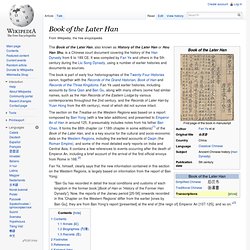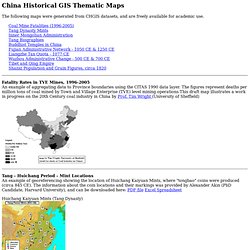

Book of the Later Han. The book is part of early four historiographies of the Twenty-Four Histories canon, together with the Records of the Grand Historian, Book of Han and Records of the Three Kingdoms.

Fan Ye used earlier histories, including accounts by Sima Qian and Ban Gu, along with many others (some had similar names, such as the Han Records of the Eastern Lodge by various contemporaries throughout the 2nd century, and the Records of Later Han by Yuan Hong from the 4th century), most of which did not survive intact. The section on the Treatise on the Western Regions was based on a report composed by Ban Yong (with a few later additions) and presented to Emperor An of Han in around 125.
It presumably includes notes from his father Ban Chao. Fan Ye, himself, clearly says that the new information contained in this section on the Western Regions, is largely based on information from the report of Ban Yong: Contents[edit] Annals (紀)[edit] Biographies (列傳)[edit] Records (志)[edit] [edit] References[edit] General. H109 Ceramic in China - Ceramic History Tutorials for Potters and Clay Artists. A Visual Sourcebook of Chinese Civilization. CHGIS Thematic Maps. The following maps were generated from CHGIS datasets, and are freely available for academic use.

Fatality Rates in TVE Mines, 1996-2005An example of aggregating data to Province boundaries using the CITAS 1990 data layer. The figures represent deaths per million tons of coal mined by Town and Village Enterprise (TVE) level mining operations.This draft map illustrates a work in progress on the 20th Century coal industry in China by Prof. Tim Wright (University of Sheffield) Tang - Huichang Period - Mint LocationsAn example of georeferencing showing the location of Huichang Kaiyuan Mints, where "tongbao" coins were produced (circa 845 CE).
The information about the coin locations and their markings was provided by Alexander Akin (PhD Candidate, Harvard University), and can be downloaded here: PDF file Excel Spreadsheet Huichang Kaiyuan Mints (Tang Dynasty) Mongolian Administrative and Geographic Units (Qing Dynasty) Hometown locations for biographical entries in CHS (Tang Dynasty) A Visual Sourcebook of Chinese Civilization. Three Kingdoms. The Three Kingdoms (CE 220–280),[1] a tripartite between the states of Wei (魏), Shu (蜀), and Wu (吳),[2][3] followed the loss of the de facto power of the Han dynasty in China, ushering in the start of the Period of Disunity.[1] To further distinguish the three states from other historical Chinese states of the same name, historians have added a relevant character: Wei is also known as Cao Wei (曹魏), Shu is also known as Shu Han (蜀漢), and Wu is also known as Dong (or Eastern) Wu (東吳).

The term "Three Kingdoms" itself is something of a mistranslation, since each state was eventually headed not by a king, but by an emperor who claimed legitimate succession from the Han dynasty. Nevertheless, the term "Three Kingdoms" has become standard among sinologists. Although relatively short, this historical period has been greatly romanticized in the cultures of China, Japan, Korea, and Vietnam. §Periodization[edit] There is no set time period for the era, and many arbitrary definitions are given. Chinese prehistory and fossil evidence for human evolution. Links. Ancient China. Indian, Chinese, & Japanese Emperors. India and China are the sources of the greatest civilizations in Eastern and Southern Asia. Their rulers saw themselves as universal monarchs, thereby matching the pretensions of the Roman Emperors in the West. The only drawbacks to their historical priority were that India suffered a setback, when the Indus Valley Civilization collapsed (for disputed reasons), and China got started later than the Middle Eastern civilizations.
By the time India recovered, it was a contemporary of Greece, rather than Sumeria, with many parallel cultural developments, like philosophy. And, curiously, China reached a philosophical stage of development in the same era, the "axial age," 800 to 400 BC. The Art of Asia. IGCS - Archaeology (China WWW VL - Internet Guide for Chinese Studies) The Great Wall of China. Timeline. Chinese Art Net - Art Museum Links.